Abstract
The study of the Earth’s magnetosphere through in situ observations is an important step in understanding the evolution of the Sun–Earth interaction. In this context, the long-term observation of the Earth’s magnetotail using a scientific probe in a high elliptical orbit is a challenging mission scenario due to the alignment of the magnetotail direction with the Sun–Earth line, which requires a continuous rotation of the apse line of the spacecraft’s geocentric orbit. This aspect makes the mission scenario particularly suitable for space vehicles equipped with propellantless propulsion systems, such as the classic solar sails which convert the solar radiation pressure into propulsive acceleration without propellant expenditure. However, a continuous rotation of the apse line of the osculating orbit can be achieved using a more conventional solar electric thruster, which introduces an additional constraint on the duration of the scientific mission due to the finite mass of the propellant stored on board the spacecraft. This paper analyzes the potential of a typical CubeSat equipped with a commercial miniaturized electric thruster in performing the rotation of the apse line of a geocentric orbit suitable for the in situ observation of the Earth’s magnetotail. The paper also analyzes the impact of the size of a thruster array on the flight performance for an assigned value of the payload mass and the science orbit’s characteristics. In particular, this work illustrates the optimal guidance laws that allow us to maximize the duration of the scientific mission for an assigned CubeSat’s configuration. In this sense, this paper expands the literature regarding the study of this interesting mission scenario by extending the study to conventional propulsion systems that use a propellant to provide a continuous and steerable thrust vector.
1. Introduction
The study of the dynamics of the Earth’s magnetosphere through in situ observations carried out by robotic space probes [1,2,3] represents an important step in the refinement of mathematical models that describe the complex interaction between the Sun and the Earth–Moon system [4,5,6,7]. The success of NASA’s robotic Magnetospheric Multiscale (MMS) mission launched in 2015 [8,9], which has been significantly extended from the planned two years’ duration and which is expected to continue operating (hopefully) into the next decade [10,11], demonstrates the interest of space agencies in studying the Earth’s magnetosphere via robotic scientific probes. In this specific case, the MMS mission uses four (identical) spin-stabilized space vehicles orbiting in a close formation along a highly elliptical geocentric orbit with a perigee distance of and an apogee distance of (or ), where is the Earth’s mean reference radius. The latter is assumed, in this work, to be equal to . More specifically, the apogee distance of is used for the so-called “phase 1”, while the orbit with the apogee at is used for “phase 2” of the scientific mission. In particular, phase 1 of the MMS mission aims to observe Earth’s mid-latitude dayside magnetopause, while phase 2 allows the close spacecraft formation to observe the nightside magnetic neutral sheet of the magnetosphere [12,13]. Conceptually similar in design to NASA’s MMS mission, the Cluster II mission was developed by the European Space Agency and launched in 2000 after an initial catastrophic (launch) failure due to the explosion of the Ariane 5 rocket in 1996 [14,15]. The Cluster II mission, which just officially ended its work in September 2024, also used a tetrahedral flight formation of four identical satellites in a highly elliptical geocentric orbit with an inter-vehicle separation distance significantly higher than in the MMS case. The characteristics of such a science orbit allowed the scientific payload of the spacecraft to obtain in situ observations of the Earth’s upper magnetosphere over roughly two solar cycles, while the combined use of measurements from the MMS and Cluster II missions has helped us to better understand the physical structure of the region of space surrounding Earth [16]. On the other hand, the interest of the scientific community in this aspect has been confirmed by the significant number of scientific publications that have appeared in recent years which aim to propose increasingly advanced and refined analytical (and numerical) models that allow the valuable experimental results obtained by orbiting probes to be incorporated [17,18,19,20].
In the context of the robotic exploration of the Earth’s magnetosphere, a continuous and long-term observation of the magnetotail can be achieved through an elliptical science orbit whose apogee has a sufficiently large radius and remains within the tail [21,22]. However, the in situ observation of the Earth’s magnetotail is a rather challenging mission scenario due to the inherent difficulty of continuously rotating the apse line of the science orbit to align with the Sun–Earth line, which rotates with respect to an inertially fixed direction by about one degree per day. For this reason, such an interesting mission scenario has been repeatedly studied in the literature as a potential application of a photonic solar sail [23,24,25], even in contexts other than terrestrial ones, as was very recently analyzed by the author in the case of the study of the induced magnetosphere of Venus [26]. A solar sail-based propulsion system, as is known, exploits the solar radiation pressure to generate thrust [27,28] thanks to the use of a large, highly reflective surface, whose mass-to-area ratio is specifically designed to be as low as possible, compatible with the available level of technology [29,30]. In this context, in the mid-1990s a mission concept called GeoSail [31,32,33,34,35,36] was proposed in which a spacecraft propelled by a photonic solar sail would be inserted into a highly elliptical geocentric orbit having its apogee in the region of circumterrestrial space occupied by the magnetotail, and whose apse line would be artificially rotated to follow the Sun–Earth line in real time. In its basic design, as thoroughly described in the interesting Ref. [36], the proposed GeoSail mission used a solar sail with a reflective surface area of about (corresponding, in the case of a square sail shape, to having a side of ) which was capable of providing a maximum propulsive acceleration (at the mean Earth–Sun distance of ) of about . The spacecraft on which the photonic solar sail was installed had a launch mass of with a scientific payload mass of . As a result, the solar sail provided a maximum thrust magnitude of about during the planned two-year duration of the scientific mission. In particular, the GeoSail’s payload core instrument suite [36] was formed by a flux-gate magnetometer, an electrostatic analyzer, a solid-state telescope, a search coil magnetometer, and a set of data processors, with the total electric power required equal to . Subsequently, i.e., in the early 2000s [32,34], the design parameters of the proposed GeoSail mission were refined to consider a square solar sail with a side of which was capable of providing a maximum (reference) propulsive acceleration of about , with a total sail system mass at launch of roughly and a spacecraft nominal on-orbit mass of . In this context, a new value of the payload mass, equal to about , has also been identified in order to allow for a sort of extended scientific mission, while a specific reference orbit (hereinafter referred to as a “science orbit”) has also been selected, having a perigee radius of and an apogee radius of [32,34].
A possible alternative to the use of an unconventional propulsion system such as a solar sail involves the use of a much more common electric thruster [37,38], which is able to provide a continuous, steerable, and, within certain limits, variable thrust. In fact, the option of using an electric thruster as the primary propulsion system was considered during the preliminary study of the GeoSail mission, as highlighted by the literature of the time [32,34]. In particular, the possibility of carrying out a scientific mission similar to the one planned for GeoSail using the Qinetiq T5 electric thruster [39,40] was analyzed in detail, and the results are discussed in Ref. [32]. The study led to the conclusion that, to have a flight time of two years, a propellant mass of roughly and a spacecraft with a nominal on-orbit mass of (the resulting launch mass is ) was required. However, technological advances over the past two decades have allowed for the construction and flight validation of increasingly smaller and more efficient space systems [41,42,43]. This remarkable aspect of space technology is evidenced by the growing number of CubeSats [44] deployed in Earth orbit and the recent ability to equip these (small) space vehicles with advanced propulsion systems [45] such as electric thrusters [46,47,48] or even photonic solar sails, as in the case of the (ill-fated) NASA NEA Scout mission [49,50,51]. In particular, it is precisely the combination of the CubeSat concept—i.e., the concept of a highly standardized spacecraft with relatively lower development costs than a more conventional vehicle—and that of an electric propulsion system—i.e., an engine capable of providing continuous thrust with a high specific impulse value—that makes this option potentially suitable for carrying out a medium–long-term scientific observation of the Earth’s magnetotail. The question related to the duration of the scientific mission therefore remains open; that is, it is necessary to investigate whether a typical CubeSat equipped with an electric thruster whose characteristics are similar to those of the engines currently marketed is able to allow for a mission lifetime similar to that originally planned for GeoSail, i.e., about two years.
This paper tries to give a first, preliminary answer to this interesting question by analyzing the performance obtainable by a typical CubeSat equipped with a commercial electric thruster on a scientific mission for the exploration of the magnetotail substantially similar to that of GeoSail, that is, considering the same (baseline) value of the payload mass and the same science orbit around the Earth. The use of a CubeSat in this specific mission scenario, to the best of the author’s knowledge, has not yet been studied in the literature. More specifically, the study illustrated in this paper considered the performance characteristics of the BIT-3 electric thruster, which is an iodine gridded ion (miniaturized) propulsion system marketed by the company Busek Co. Inc. (Natick, MA, USA) [52]. The reason for this specific choice is linked to the fact that this miniaturized electric thruster has already been installed on board some CubeSats in the recent past, such as on the two Lunar IceCube and LunaH-Map missions launched for the study of the Moon’s surface, and has therefore reached a considerable degree of technological maturity [53,54]. Moreover, the presence in the scientific literature of a simple (but sufficiently accurate) mathematical description capable of modeling the BIT-3’s propulsive performance [55,56] allows the designer to easily include the thrust model in the automated numerical routines for the design of the CubeSat’s geocentric trajectory. In this respect, the author [57] indeed recently employed such a surrogate model of the BIT-3 thrust vector to analyze the impact of the size of an array of miniaturized electric thrusters in a heliocentric mission scenario, which involved the close approach of an interplanetary CubeSat to a near-Earth asteroid. This work, on the other hand, used a slightly simpler thrust model formulation than the one illustrated in Ref. [57] by using the nominal performance data declared by the manufacturing company in Ref. [52]. This thrust model is described in the first part of Section 2, which contains, in its second part, a simplified analysis of the CubeSat mass distribution. The latter was obtained by assuming that the spacecraft’s electric power subsystems are based on the use of commercial solar panels modeled on the MMA’s HaWK solar arrays [58]. Also, in the case of the spacecraft mass breakdown, the starting point was the model proposed in Ref. [57], which was adapted to the geocentric case treated by this paper, taking into account both the characteristics of the scientific payload and the typical electric power requirements of the CubeSat.
In Section 3, the paper discusses the optimal steering laws that allow us to minimize the propellant mass in order to achieve the maximum mission lifetime for a given mass distribution of the CubeSat. The variation of the optimized mission lifetime with the design characteristics of the CubeSat is then parametrically investigated by considering a number of potential spacecraft configurations with the same payload mass. That parametric study also considers the employment of a small array of miniaturized electric thrusters and the presence of additional propellant tanks in the CubeSat. In this context, with the aim to reduce the computation time required to explore a number of potential configurations and according to the interesting (and elegant) approach used by McInnes et al. [36] in 2001, a simplified (two-dimensional) spacecraft dynamics model is used to describe the temporal variation in the orbital parameters of the CubeSat’s osculating orbit, as detailed in the first part of Section 3. The results of the numerical simulations are finally illustrated in Section 4, while Section 5 contains the conclusions of the work.
2. Description and Modeling of CubeSat
The aim of this section is to describe the following: (1) in the first part, the simplified model of the thrust vector, taking into account the actual performance of the BIT-3 thruster that is supposed to equip the CubeSat; (2) in the second part, the mathematical model used to schematize the distribution of the spacecraft masses, taking into account the characteristics of the scientific payload and the total electric power required by the propulsion system. A cutaway of Busek’s BIT-3 engine unit (with an integrated gimbal) is shown in Figure 1.
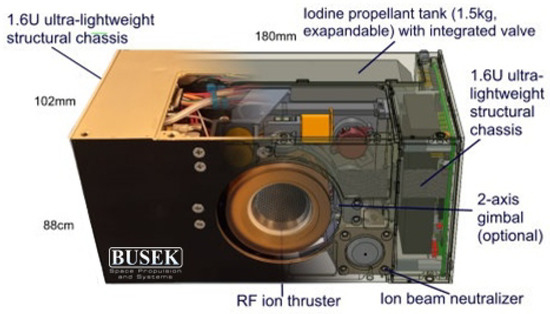
Figure 1.
System layout of BIT-3 (gimbaled) engine unit with integrated propellant tank, which contains of solid iodine. Image courtesy of Busek Co. Inc.
In particular, the mathematical models illustrated in this section are largely derived from those recently used by the author [57] for the study of the mission of an interplanetary CubeSat equipped with a continuous-thrust propulsion system whose characteristics are consistent with those of the BIT-3 electric thruster. In this sense, the models described below can be considered as an application to the geocentric case (and therefore a possible completion) of the more general models presented in Ref. [57]. In order to facilitate the potential reader in understanding the comparison between the model illustrated in the next subsections and that in the recent literature [57], the same nomenclature will be substantially maintained, but comments relating to the specific design choices will be reduced to a minimum, referring to Ref. [57] for further insights.
2.1. Electric Thruster Mathematical Model
According to Courtney et al. [59], Busek’s BIT-3 is a highly integrated and compact propulsion system that can be considered a kind of “plug-n-play” miniaturized electric thruster with a total mass of (with a gimbal) enclosed in an ultra-lightweight structural chassis of (the so-called engine unit); see Figure 1. In particular, a single BIT-3-based engine unit [52], which also includes a propellant tank with of solid iodine, provides a maximum thrust of with a propellant mass flow rate of and a required electric power of . The thrust magnitude of the electric engine can be throttled, within a small range, by varying the power processing unit input power, as described by the surrogate (linear) model proposed by Tsay et al. [55] and used in Ref. [57] in a heliocentric transfer. In this work, keeping in mind the specific mission scenario in which the thruster will have to operate for a long period of time (recall that the GeoSail-type mission lifetime is two years), we chose to further simplify the miniaturized thruster’s mathematical model by considering only two admissible values for the thrust magnitude provided by a single engine unit (subscript , as in Ref. [57]), viz.
Clearly, the condition models the case where the thruster is turned off, while the value indicates that the unit provides the maximum allowable thrust magnitude. Consequently, within the simplified thrust model adopted in this work, the propellant mass flow rate is simply given by the following relation:
while the electric power required for the single engine unit’s operation is
For the case where the CubeSat is equipped with an array of engine units, the total thrust T, the required electric power P, and the propellant mass flow rate of the small spacecraft can be obtained using Equations (1) and (2). More specifically, according to the results of Ref. [57], in the remainder of this paper we will assume that because the case of is hardly compatible with the volumetric characteristics of a typical CubeSat, because a single engine unit occupies a volume of . In this simplified context where , assuming that all engine units in the array are activated simultaneously and taking into account Equations (1)–(3), the expressions of T, P, and are simply obtained as
Therefore, according to the previous equation, one has three possible values of T, , and P, as is reassumed in Table 1, where the propellant mass flow rate is expressed in milligrams per day.

Table 1.
Maximum value (case with all engine units turned on) of the thrust magnitude T, propellant mass flow rate , and required electric power as a function of the size N of the thruster array.
Note that the possibility of simultaneously activating a number of engine units lower than N has been preliminarily studied through a numerical simulation of the mission lifetime for a series of potential CubeSat configurations. The results obtained indicate, however, that the number of activated engine units has a very marginal impact on the mission duration (it is a matter of a few days of difference between the extreme cases of a single activated unit or all units activated), and, in this context, the simultaneous activation of all the available units allows us to obtain the best performance in terms of the total flight time. On the other hand, the value of the lifetime of a single propulsion unit indicated by Tsay et al. [54] is compatible with the GeoSail-type mission requirements.
As for the direction of the thrust vector , it is assumed that the latter is not constrained, as is usually assumed in missions involving the use of an electric thruster. Bearing in mind that in Section 3 a two-dimensional model for the spacecraft’s geocentric dynamics will be used, the thrust vector is conveniently expressed in a classical radial–transverse (rotating) reference frame [60], in which is the radial unit vector (whose direction is aligned with the Earth–CubeSat line) and is the transverse unit vector positive in the direction of motion. In this context, is written as
where T is given by Equation (4) as a function of N, and is the thrust angle, which is considered one of the control terms in the design of the guidance law, as described in Section 3. In particular, is the angle between the Earth–CubeSat line and the direction of the thrust vector, with when the thrust increases the specific mechanical energy of the CubeSat’s osculating orbit.
The local propulsive acceleration vector of the CubeSat can be easily obtained from Equation (5) as
where m is the current mass of the spacecraft, whose initial value —i.e., the CubeSat mass calculated at time , at which the scientific mission begins—is obtained using the simplified mathematical model described in the next subsection. Note that, according to Equation (6), the radial and transverse components of the propulsive acceleration vector are given by
which, for an assigned value of N, are the functions of two control terms, namely the thrust angle and the (binary) switching state of the BIT-3-based propulsion system; see also Equation (1).
2.2. Potential CubeSat Arrangements and Mass Breakdown Model
The initial value of the CubeSat mass , which will be needed to initialize the differential equation giving the temporal variation in the spacecraft’s total mass, m, is calculated as a function of the size N of the thruster array using a simplified mathematical model that adapts the results obtained in Ref. [57] to this geocentric mission scenario.
For this purpose, the value of is considered as the sum of the following terms: the mass of the electric thruster array (each of the N engine units, recall, contains of propellant); the total mass of possible additional tanks, each of which is assumed to contain of propellant (Mike Tsay, personal communication, 5 February 2025) (i.e., solid iodine); the mass of the power generation system based on the use of classical solar panels; the mass of the scientific payload, whose value coincides with that of the GeoSail probe as indicated in Ref. [36]; and the mass that considers all the remaining CubeSat subsystems, including an appropriate contingency factor. Note that the case of indicates that no engine unit hosts an additional tank, while, for example, if and (or and ), it means that a single engine unit out of the two installed (or both engine units) has an additional propellant tank.
In particular, the mass of the power system is calculated by estimating the total electric power required by the CubeSat and considering a power-to-mass ratio equal to , which is consistent with the characteristics of the MMA’s High Watts per Kilogram “HaWK” solar arrays [58]. Bearing in mind that (1) each engine unit requires an electric power of to provide the maximum thrust magnitude [52], (2) the scientific payload requires an electric power of roughly to operate along the assigned science orbit [36], and (3) there is a sort of contingency electric power of to operate the other subsystems, one obtains the value of as
which is a (linear) function of the size N of the thruster array. As for the mass of the other subsystems (including a suitable contingency factor), it is considered a fraction of the total initial mass of the spacecraft in accordance with what was performed in Ref. [57], i.e., we assume that .
Accordingly, the initial (total) mass of the CubeSat is written as
which gives the following, compact, expression of :
The total propellant mass stored on board the CubeSat is therefore
so that one obtains the constraint on the current value of the spacecraft mass
Bearing in mind that and , one has nine possible CubeSat configurations, i.e., nine possible values of and , as is reassumed in Table 2 and Table 3. The corresponding CubeSat mass distribution is detailed in Figure 2.

Table 2.
Approximate value of the CubeSat’s initial mass (in kilograms), as a function of N and n.

Table 3.
Total propellant mass (in kilograms) stored on board the CubeSat, as a function of N and n.
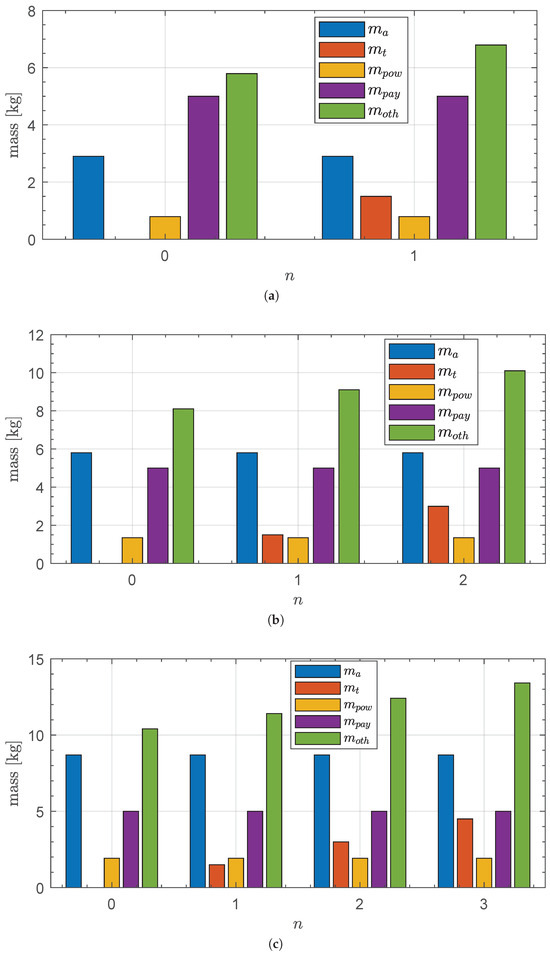
Figure 2.
Mass distribution of the nine possible CubeSat configurations as a function of N and n. (a) Case of ; (b) case of ; (c) case of .
Note that the case of gives a CubeSat initial mass, , well above , which, according to the rule of thumb of 2 kilograms per unit, should be the maximum mass for a typical CubeSat. In any case, the case will also be analyzed in order to have an estimate of the potential performance of the BIT-3-based CubeSat in the case of a higher launch mass, as in the case of a less common CubeSat [61].
In the following, in order to simplify the characterization of the control law that will be discussed in the next section and to reduce the computation time, for a given value of N two possible values of the number of additional tanks will be considered, namely . In this way, the CubeSat’s performance will be investigated in two important cases in which (1) all the installed engine units have only the default propellant tank (case of ) and (2) all the engine units have an additional propellant tank installed (case of ). The mass breakdown results, in terms of the mass percentage when and , are summarized in the pie charts collected in Figure 3. Note that in the case of , the mass fraction of the payload is about of , while when the fraction drops to ; see Figure 3d,f.

Figure 3.
CubeSat’s mass breakdown when and . (a) Case of and ; (b) case of and ; (c) case of and ; (d) case of and ; (e) case of and ; (f) case of and .
3. Spacecraft Dynamics and Guidance Law
The first part of this section illustrates the mathematical model used to describe the electric thruster-propelled CubeSat motion in the GeoSail-type mission scenario. In particular, paralleling the procedure used by McInnes et al. [36], the spacecraft’s geocentric dynamics are described by using a reduced (Gaussian) form of Lagrange’s planetary equations, as reported in the classic textbook by Stark et al. [60]. In this context, only the effects of the gravitational (Keplerian) attraction of the Earth and the thrust provided by the BIT-3-based propulsion system are taken into account, while the eclipse periods and orbit perturbations are neglected to simplify the study.
In the second part of this section, the simplified dynamics of the spacecraft are then used to obtain the CubeSat guidance law in terms of the variation with the (osculating orbit’s) true anomaly of the thrust angle and the switching state of the thruster array. In this regard, an optimization approach is employed to derive the optimal guidance law that minimizes the propellant mass needed to rotate the apse line of the assigned science orbit by a suitable angle, in order to realign that line with the Sun–Earth direction at the end of nearly one revolution of the CubeSat around the planet. Keeping in mind that the total propellant mass is assigned—see Table 3—minimizing fuel consumption leads to maximizing the scientific mission duration. To simplify the problem, the Earth is assumed to cover a circular heliocentric orbit of a radius equal to one astronomical unit, so that the Sun–Earth line rotates with a constant angular velocity equal to .
3.1. The Simplified Geocentric Dynamics of the CubeSat
The CubeSat’s geocentric dynamics are described in terms of the osculating orbit’s semimajor axis a; eccentricity e; true anomaly , as defined in Ref. [60]; and apse line rotation angle , whose initial value (i.e., the value at the beginning of the scientific mission, ) is assumed to be equal to zero. The latter assumption corresponds to considering an apse line aligned with the Sun–Earth direction at time . Bearing in mind that the science orbit has a perigee radius of and an apogee radius of [32,34]—see the scheme in Figure 4—the initial values of the semimajor axis and the eccentricity are obtained as
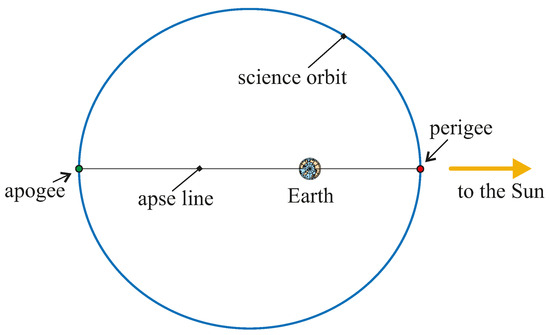
Figure 4.
CubeSat science orbit ( geocentric ellipse) for the observation of the Earth’s magnetotail.
Moreover, we assume that at the CubeSat is in the orbit’s perigee, so that one has . In particular, according to Ref. [60] and using Equation (7) to express the two components of the propulsive acceleration vector, the variation with of the CubeSat’s state variables is given by the following set of first-order non-linear differential equations:
where
Finally, taking into account that the -variation of the time t is approximately given by [60],
the variation of the CubeSat mass m with the osculating orbit’s true anomaly is written as
in which the propellant mass flow rate and the thrust magnitude T are given by Equation (4) as a function of the size N and the switching state of the array of miniaturized electric thrusters. The -variation of the thrust angle and the switching state is determined through the optimization process described in the next subsection.
3.2. Trajectory Optimization and Optimal Guidance Laws
The thrust angle and the thrust magnitude T, i.e., the direction of vector and the switching state of the thruster array as modeled by Equations (1) and (4), are determined in order to minimize the propellant mass required to obtain, when with , an osculating orbit with the following characteristics: (1) the apse line is perfectly aligned with the Sun–Earth line; (2) the semimajor axis is equal to ; and (3) the eccentricity is equal to . Note that the time at which , i.e., the time instant , is obtained through the (numerical) integration of Equation (18) in the true anomaly interval by employing the optimal guidance law described later in this section. Consequently, the alignment condition of the apse line of the CubeSat’s geocentric osculating orbit and the Sun–Earth direction gives the following constraint:
where the value of is fixed, while the two conditions on the semimajor axis and the eccentricity are simply expressed as
The conceptual scheme of the rotation of the science orbit at three generic time instants, , is shown in Figure 5. Note that in the sketch in Figure 5 the three osculating orbits are only drawn at the three instants in time, but the effect of the propulsive acceleration continuously modifies the geocentric trajectory of the CubeSat to ensure that the apse line follows the Earth–Sun line during the scientific mission.
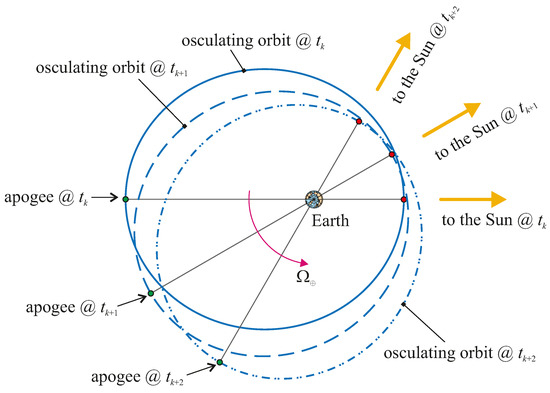
Figure 5.
Conceptual scheme of the rotation of the science orbit.
The analysis of the optimal guidance law can be simplified by using a recursive type of approach where the variation of the thrust angle and the switching state of the thruster array with are studied within the generic (reduced) interval . In particular, at the beginning of the generic interval (i.e., when ) the semimajor axis of the osculating orbit is equal to , and the eccentricity is equal to , while the values of m and coincide with those obtained at the end of the previous (reduced) interval. Recall that the value of the CubeSat mass m influences the value of the two propulsive acceleration components and , since the thrust magnitude (when the thruster array is turned on, of course) is fixed when the value of N is selected. On the other hand, at the end of the generic interval (i.e., when ), both the semimajor axis and the eccentricity of the osculating orbit are constrained to return to their initial values, and , respectively, and the angle reaches the following value:
which allows the apse line to realign again with the Sun–Earth line at time . In particular, the CubeSat mass at the end of the interval is maximized to optimize the propellant consumption, i.e., to minimize the propellant mass required to complete the generic (reduced) interval.
To this end, an indirect approach [62] is used to minimize the propellant consumption, and Pontryagin’s maximum principle [63] is employed to obtain the corresponding guidance law. In this context, we consider the CubeSat’s state variables , the adjoint variables [64], and the Hamiltonian function , defined as
where the derivatives with respect to in the right terms are obtained using Equations (14)–(16) and (19). The variation with of the generic adjoint variable is obtained using the Euler–Lagrange equations [65]:
while the transversality condition [66] gives the required value of at the end of the generic (reduced) interval:
According to Pontryagin’s maximum principle, the value of angle and the switching state of the thruster array are obtained by maximizing, at any , the value of . In this regard, recalling that the direction of the thrust vector is unconstrained, the necessary condition gives the optimum value of , viz.
where and are two auxiliary functions defined as
Finally, regarding the switching state of the thruster array, observing that when the thruster array is turned off, i.e., when and , and keeping in mind Equation (4), the value of the Hamiltonian function when the thruster array is turned on is given by
Now, if at a generic instant of time the value of is negative, then it means that a higher value of (i.e., the value of zero) can be obtained simply by turning off the propulsion system. In other words, , defined in Equation (29), plays the role of a sort of switching function. Therefore, the Hamiltonian function is maximized when the switching state of the thruster array is selected with the law
so that the total thrust magnitude is given by
while the propellant mass flow rate is
4. Numerical Simulations
The optimization procedure described in the previous section was employed to calculate the performance of the BIT-3-propelled CubeSat which uses a thruster array with and in a GeoSail-type mission scenario. In particular, the recursive approach was used to calculate the mission lifetime by minimizing the propellant mass required to complete the generic (reduced) interval of . In this context, the exit condition of the recursive cycle was the violation of the constraint on the minimum mass of the CubeSat given, as a function of N and n, by Equation (12).
The results of the numerical simulations indicated that the case where , i.e., the case where the CubeSat is equipped with a single engine unit (regardless of the presence or absence of an additional tank), is not able to satisfy the terminal constraint on the angular position of the apse line of the osculating orbit. This is probably due to the low value of the magnitude of the propulsive acceleration. On the other hand, the numerical results for the case of N = 2 and are summarized in Table 4, in terms of the mission lifetime and the final mass of the CubeSat at the end of the scientific mission. Note that the value of the spacecrafts’ final mass is consistent with the constraint given by Equation (12). The mission lifetime, as a percentage of the target value of , is also illustrated in Figure 6.

Table 4.
Numerical results, in terms of the mission lifetime and final CubeSat mass, of the optimization procedure for a GeoSail-type mission as a function of and .
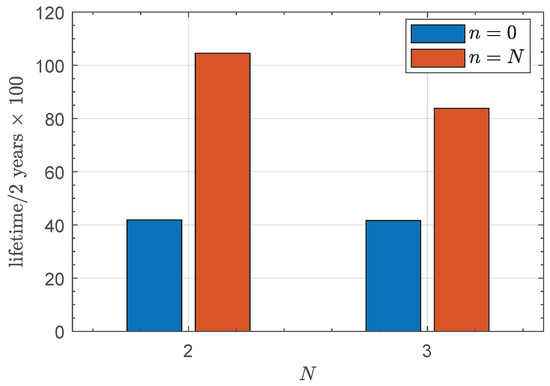
Figure 6.
Mission lifetime as a percentage of the target value of .
According to the graph in Figure 6, only the configuration in which the CubeSat is equipped with two engine units and two additional tanks is able to reach a mission duration greater than . On the other hand, as expected, the case of is not even able to approach the target value, reaching, when , just of the two years required. This result is evident in Figure 7, which shows the CubeSat’s geocentric trajectory in the case of .
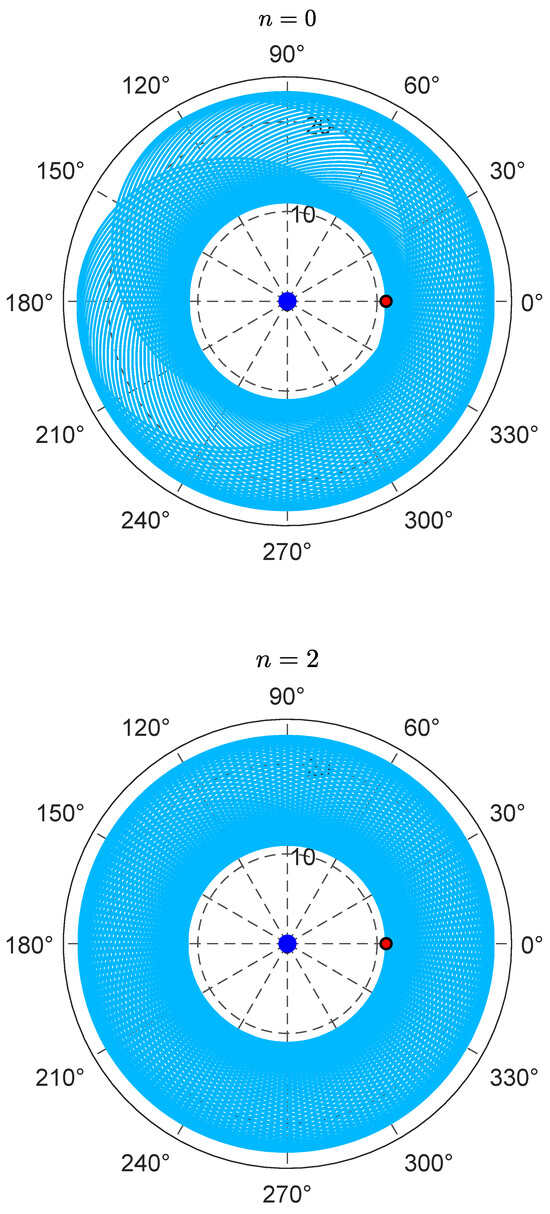
Figure 7.
CubeSat trajectory when and . Blue circle → Earth; red dot → starting point which coincides with initial perigee.
The CubeSat trajectory in the case of is shown in Figure 8. Both Figure 7 and Figure 8 clearly show the rotation of the apse line of the spacecraft’s osculating orbit, which essentially provides motion for the CubeSat that evolves in a geocentric annular region between the perigee () and apogee radius () of the science orbit.
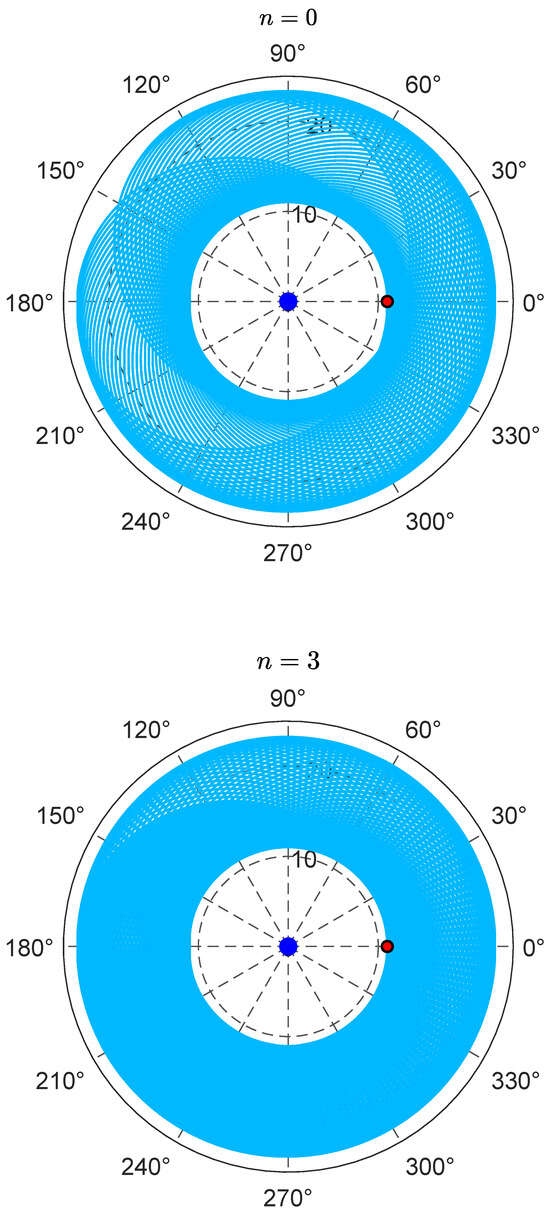
Figure 8.
CubeSat trajectory when and . Blue circle → Earth; red dot → starting point which coincides with initial perigee.
In the set of cases illustrated in this section, from the author’s point of view, the one relating to the configuration with two engine units and two additional tanks, i.e., the case of and , appears particularly interesting. In fact, taking into account that the mass of this configuration is substantially compatible with a CubeSat—see Table 2—we come to the conclusion that the case of and can be considered a potential candidate for the realization of a GeoSail-type mission in the event that one decides to use a CubeSat and an array of commercial electric thrusters to observe the Earth’s magnetotail in a time interval of roughly 2 years. For this reason, the characteristics of the optimal control law and the variation with of the orbital elements of the CubeSat’s osculating orbit are now analyzed in detail.
In this context, Figure 9 shows the temporal variation in a, e, and during the scientific mission. Note that the values of a and e remain close to their design values ( and , respectively) throughout the duration of the mission, while the angle has substantially linear variation in time.
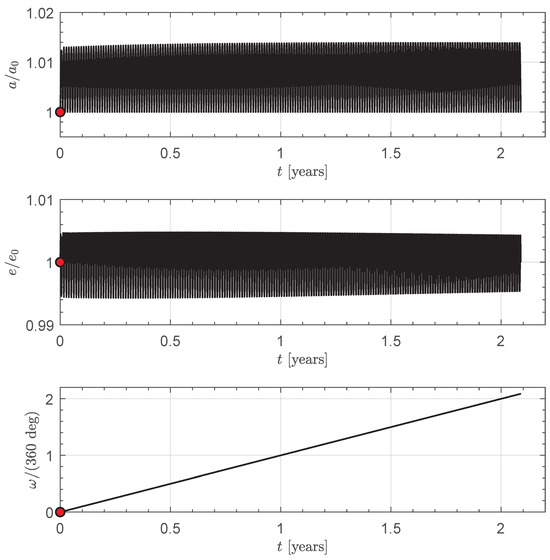
Figure 9.
Time variation of the orbital elements of the CubeSat’s osculating orbit when and . Red dot → starting point.
The fulfillment of the condition relating to the rotation of the apse line of the osculating orbit emerges from Figure 10, which shows in the same graph the temporal variation in (solid black line), which gives us the angular position of the apse line, and the product (dashed red line), which gives us the angular position of the Sun–Earth line. In fact, the two lines are substantially superimposed during all the scientific mission durations.

Figure 10.
Time variation of and the angular position of the Sun–Earth line given by , when and .
The variation of with along the first reduced interval is shown in Figure 11, in which the dashed red line again indicates the product . Note that at the end of the reduced interval, while both a and e return to their initial values.
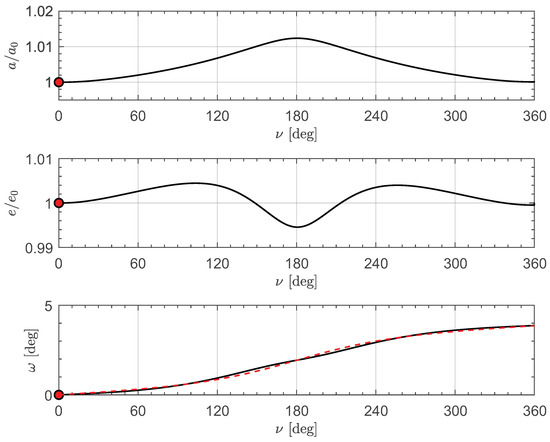
Figure 11.
Variation in along the first reduced interval when . Red dot → starting point; red dashed line →.
The corresponding -variation of the thrust angle and the thrust magnitude T is reported in Figure 12, in which one can observe that the thruster array is always turned on during the first reduced interval, while the thrust angle ranges between the two boundaries of the admissible range, i.e., . The shape of the optimal thrust angle variation along the generic reduced interval clearly changes during flight, as the propulsive acceleration increases due to propellant consumption, although it does not become very different from that drawn at the top of Figure 12.
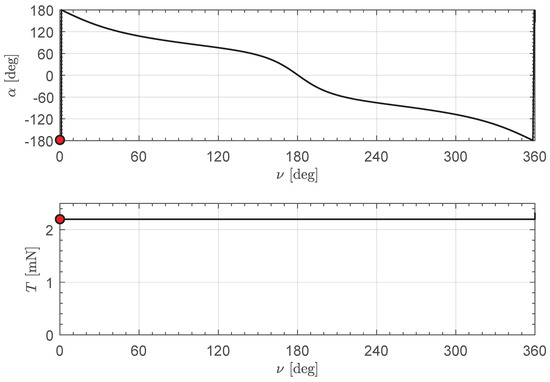
Figure 12.
Variation with of the two control terms along the first reduced interval when . Red dot → starting point.
The CubeSat’s mass reduction during the flight is evident in Figure 13, which shows the two functions and during the first reduced interval .
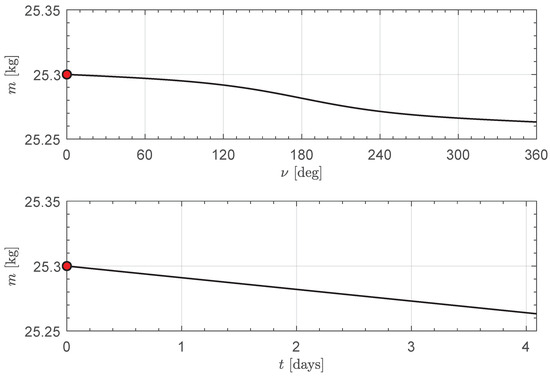
Figure 13.
Variation with (or t) of the CubeSat’s total mass during the first reduced interval, when . Red dot → starting point.
We observed that the linear variation with time of the CubeSat’s mass is consistent with the constant value of the propellant mass flow rate and the fact that the thruster array is always turned on during the reduced interval, with a constant value of the thrust magnitude which is indeed equal to ; see also Equation (4) in which . Finally, the shape of the function reflects the temporal variation in the spacecraft’s true anomaly during the geocentric flight.
5. Conclusions
The maturity of the CubeSat hardware components, the ability to realize increasingly smaller spacecraft components, and the recent possibility of designing miniaturized high-performance propulsion systems, which provide continuous and adjustable thrust, allow us to consider new and challenging mission scenarios for these interesting small spacecrafts. In this regard, the numerical results obtained in this study indicate that a CubeSat equipped with two engine units, whose characteristics are consistent with those of the well-known Busek BIT-3 RF ion thruster, is potentially capable of carrying out a fascinating scientific mission for the observation of the Earth’s magnetotail like that of the (proposed) GeoSail probe. In this scenario, the electric thruster is required to operate, in a substantially continuous manner, for a long period of time, and this aspect could lead to the temporal validity limits of its main components being reached. In this sense, a mission scenario like the one analyzed in this paper could be considered particularly challenging for a propulsion system like the one used in the presented model.
Clearly, the finite (and still small for a conventional CubeSat) amount of on-board propellant does not allow us to extend the scientific mission beyond the two years planned, unlike what a spacecraft propelled by a classic solar sail is theoretically capable of doing. However, a possible solution to this type of problem could be the use of a hybrid propulsion system that combines the technological maturity and maneuverability of an electric thruster with the ability of a solar sail to provide small propulsive acceleration for a period of time theoretically limited only by the mechanical degradation of the reflective membrane. Such a use of a CubeSat propelled by a hybrid propulsion system on a mission to observe the Earth’s magnetotail can be considered a natural extension of the study proposed in this work. Another possible extension of this work is related to the use of a more refined mathematical model to describe both the dynamics of the spacecraft in its motion around the Earth and the thrust provided by the solar electric propulsion system. In fact, if on one hand the insertion of the inevitable orbital perturbations changes the mathematical form of the spacecraft’s equations of motion, the use of the actual thrust table of the propulsion system will involve the optimal selection of the thrust level among those admissible. The results obtainable in that context can obviously coincide with those determined in this work in a case in which, as often happens, the engine is used at the maximum thrust available at a generic instant in time.
Funding
This research received no external funding.
Data Availability Statement
The original contributions presented in this study are included in this article; further inquiries can be directed to the corresponding author.
Acknowledgments
The author is indebted to Mike Tsay for the kind permission to use the BIT-3 image and for making the material and data available. The author declares that he has not used any kind of generative artificial intelligence in the preparation of this manuscript, nor in the creation of images, graphs, tables, or related captions.
Conflicts of Interest
The author declares no conflicts of interest.
Abbreviations
The following abbreviations are used in this manuscript:
| a | osculating orbit semimajor axis [km] |
| propulsive acceleration vector [mm/s2] | |
| radial component of propulsive acceleration [mm/s2] | |
| transverse component of propulsive acceleration [mm/s2] | |
| auxiliary function; see Equation (27) | |
| e | osculating orbit eccentricity |
| Hamiltonian function | |
| switching function (value of when the thruster array is turned on) | |
| m | CubeSat’s current mass [kg] |
| mass of the thruster array [kg] | |
| mass of the remaining subsystems [kg] | |
| mass of the propellant stored on board the CubeSat [kg] | |
| mass of the scientific payload [kg] | |
| mass of the power generation subsystem [kg] | |
| mass of the additional propellant tanks [kg] | |
| n | number of additional propellant tanks |
| N | number of engine units in the thruster array |
| propellant mass flow rate [g/s] | |
| p | osculating orbit semilatus rectum [km] |
| Earth’s mean reference radius [km] | |
| r | Earth–spacecraft (radial) distance [km] |
| apogee radius [km] | |
| perigee radius [km] | |
| auxiliary function; see Equation (28) | |
| T | thrust magnitude [N] |
| thrust vector [N] | |
| t | time [days] |
| reference time instants with [days] | |
| thrust angle [rad] | |
| adjoint to CubeSat’s state variable i | |
| Earth’s gravitational parameter [km3/s2] | |
| CubeSat’s true anomaly along the osculating orbit [rad] | |
| reference true anomalies with [rad] | |
| constant angular rate of the Sun–Earth line [rad/s] | |
| osculating orbit’s apse line rotation angle [rad] | |
| Subscripts | |
| refers to a single engine unit | |
| 0 | initial science orbit |
| k | at |
References
- El-Alaoui, M.; Walker, R.J.; Weygand, J.M.; Lapenta, G.; Goldstein, M.L. Magnetohydrodynamic Turbulence in the Earth’s Magnetotail From Observations and Global MHD Simulations. Front. Astron. Space Sci. 2021, 8, 620519. [Google Scholar] [CrossRef]
- Wei, Y.; Huang, S.; Rong, Z.; Yuan, Z.; Jiang, K.; Deng, X.; Zhou, M.; Fu, H.; Yu, X.; Xu, S.; et al. Observations of Short-period Current Sheet Flapping Events in the Earth’s Magnetotail. Astrophys. J. Lett. 2019, 874, L18. [Google Scholar] [CrossRef]
- Ergun, R.; Goodrich, K.; Wilder, F.; Ahmadi, N.; Holmes, J.; Eriksson, S.; Stawarz, J.; Nakamura, R.; Genestreti, K.; Hesse, M.; et al. Magnetic Reconnection, Turbulence, and Particle Acceleration: Observations in the Earth’s Magnetotail. Geophys. Res. Lett. 2018, 45, 3338–3347. [Google Scholar] [CrossRef]
- Beyene, F.; Angelopoulos, V. Storm-Time Very-Near-Earth Magnetotail Reconnection: A Statistical Perspective. J. Geophys. Res. Space Phys. 2024, 129, e2024JA032434. [Google Scholar] [CrossRef]
- Nykyri, K.; Di Matteo, S.; Archer, M.; Ma, X.; Hartinger, M.; Sarantos, M.; Zesta, E.; Paterson, W. Could a Low-Frequency Perturbation in the Earth’s Magnetotail Be Generated by the Lunar Wake? Geophys. Res. Lett. 2024, 51, e2024GL110129. [Google Scholar] [CrossRef]
- Hajra, R.; Echer, E.; Franco, A.M.d.S.; Bolzan, M.J.A. Earth’s magnetotail variability during supersubstorms (SSSs): A study on solar wind–magnetosphere–ionosphere coupling. Adv. Space Res. 2023, 72, 1208–1223. [Google Scholar] [CrossRef]
- Li, S.; Poppe, A.; Orlando, T.; Jones, B.; Tucker, O.; Farrell, W.; Hendrix, A. Formation of lunar surface water associated with high-energy electrons in Earth’s magnetotail. Nat. Astron. 2023, 7, 1427–1435. [Google Scholar] [CrossRef]
- Torkar, K.; Nakamura, R.; Roberts, O.; Jeszenszky, H.; Lindqvist, P.A.; Khotyaintsev, Y.; Giles, B.; Barrie, A. Active Spacecraft Potential Control in the MMS Mission: Results from Six Years in Orbit. IEEE Trans. Plasma Sci. 2023, 51, 2461–2467. [Google Scholar] [CrossRef]
- Vaverka, J.; Pavlů, J.; Nouzák, L.; Šafránková, J.; Němeček, Z.; Mann, I.; Ye, S.; Lindqvist, P.A. One-Year Analysis of Dust Impact-Like Events Onto the MMS Spacecraft. J. Geophys. Res. Space Phys. 2019, 124, 8179–8190. [Google Scholar] [CrossRef]
- Williams, T.; Palmer, E.; Godine, D.; Hollister, J.; Ottenstein, N.; Vint, B. MMS extended mission eclipse mitigation and solar wind turbulence science campaign. Adv. Astronaut. Sci. 2020, 171, 829–846. [Google Scholar]
- Williams, T.; Godine, D.; Palmer, E.; Patel, I.; Ottenstein, N.; Winternitz, L.; Petrinec, S. MMS extended mission design: Evaluation of a lunar gravity assist option. Adv. Astronaut. Sci. 2018, 167, 1053–1072. [Google Scholar]
- Svenningsson, I.; Yordanova, E.; Khotyaintsev, Y.; André, M.; Cozzani, G. Classifying the Magnetosheath Using Local Measurements From MMS. J. Geophys. Res. Space Phys. 2025, 130, e2024JA033272. [Google Scholar] [CrossRef]
- Tian, A.; Wang, Z.; Fu, H.; Guo, Z. Evidence of a Magnetic Null in Electron-Only Reconnection. Geophys. Res. Lett. 2025, 52, e2024GL113104. [Google Scholar] [CrossRef]
- Hwang, K.J.; Goldstein, M.; Wendel, D.; Fazakerley, A.; Gurgiolo, C. Cluster observations near reconnection X lines in Earth’s magnetotail current sheet. J. Geophys. Res. Space Phys. 2013, 118, 4199–4209. [Google Scholar] [CrossRef]
- Duan, A.; Cao, J.; Ma, Y.; Wei, X. Cluster observations of large-scale southward movement and dawnward-duskward flapping of Earth’s magnetotail current sheet. Sci. China Technol. Sci. 2013, 56, 194–204. [Google Scholar] [CrossRef]
- Escoubet, C.P.; Hwang, K.J.; Toledo-Redondo, S.; Turc, L.; Haaland, S.E.; Aunai, N.; Dargent, J.; Eastwood, J.P.; Fear, R.C.; Fu, H.; et al. Cluster and MMS Simultaneous Observations of Magnetosheath High Speed Jets and Their Impact on the Magnetopause. Front. Astron. Space Sci. 2020, 6, 78. [Google Scholar] [CrossRef]
- Walia, N.K.; Seki, K.; Amano, T.; Kitamura, N.; Saito, Y.; Ahmadi, T.; Gershman, D.J.; Pollock, C.J.; Giles, B.L.; Fuselier, S.A.; et al. A Study of Slow-mode Shocks in the Near-Earth Magnetotail with MMS Observations and Hybrid Simulations. Astrophys. J. 2024, 977, 117. [Google Scholar] [CrossRef]
- Ovchinnikov, I.; Naiko, D.Y.; Antonova, E. Fluctuations of the Electric and Magnetic Fields in the Plasma Sheet of the Earth’s Magnetotail According to MMS Data. Cosm. Res. 2024, 62, 10–33. [Google Scholar] [CrossRef]
- Zhang, Z.; Lu, S.; Lu, Q.; Wang, R.; Zhan, C.; Li, X.; Artemyev, A.V. Statistical Survey of Thin Current Sheets in Earth’s Magnetotail: MMS Observations. J. Geophys. Res. Space Phys. 2024, 129, e2024JA032575. [Google Scholar] [CrossRef]
- Smith, A.; Sun, W.; Slavin, J.; Rae, I. Ion-Scale Magnetic Flux Ropes and Loops in Earth’s Magnetotail: An Automated, Comprehensive Survey of MMS Data Between 2017 and 2022. J. Geophys. Res. Space Phys. 2024, 129, e2023JA032231. [Google Scholar] [CrossRef]
- Büchner, J.; Kuska, J.P.; Nikutowski, B.; Wiechen, H.; Rustenbach, J.; Auster, U.; Fornacon, K.; Klimov, S.; Petrukovich, A.; Savin, S. Three-dimensional reconnection in the Earth’s magnetotail: Simulations and observations. Geophys. Monogr. Ser. 1998, 104, 313–326. [Google Scholar] [CrossRef]
- Whipple, E.; Puetter, R.; Rosenberg, M. A two-dimensional, time-dependent, near-Earth magnetotail. Adv. Space Res. 1991, 11, 133–142. [Google Scholar] [CrossRef]
- Zhao, P.; Wu, C.; Li, Y. Design and application of solar sailing: A review on key technologies. Chin. J. Aeronaut. 2023, 36, 125–144. [Google Scholar] [CrossRef]
- Gong, S.; Macdonald, M. Review on solar sail technology. Astrodynamics 2019, 3, 93–125. [Google Scholar] [CrossRef]
- Fu, B.; Sperber, E.; Eke, F. Solar sail technology—A state of the art review. Prog. Aerosp. Sci. 2016, 86, 1–19. [Google Scholar] [CrossRef]
- Quarta, A.A. Venus magnetotail long-term sensing using solar sails. Appl. Sci. 2024, 14, 8016. [Google Scholar] [CrossRef]
- Wright, J.L. Space Sailing; Gordon and Breach Science Publishers: Philadephia, PA, USA, 1992; pp. 223–233. ISBN 978-2881248429. [Google Scholar]
- McInnes, C.R. Solar Sailing: Technology, Dynamics and Mission Applications; Springer-Praxis Series in Space Science and Technology; Springer: Berlin/Heidelberg, Germany, 1999; pp. 46–54, 119–120. [Google Scholar] [CrossRef]
- Spencer, D.A.; Johnson, L.; Long, A.C. Solar sailing technology challenges. Aerosp. Sci. Technol. 2019, 93, 105276. [Google Scholar] [CrossRef]
- Berthet, M.; Schalkwyk, J.; Çelik, O.; Sengupta, D.; Fujino, K.; Hein, A.M.; Tenorio, L.; Cardoso dos Santos, J.; Worden, S.P.; Mauskopf, P.D.; et al. Space sails for achieving major space exploration goals: Historical review and future outlook. Prog. Aerosp. Sci. 2024, 150, 101047. [Google Scholar] [CrossRef]
- Lappas, V.; Mengali, G.; Quarta, A.A.; Gil-Fernandez, J.; Schmidt, T.; Wie, B. Practical Systems Design for an Earth-Magnetotail-Monitoring Solar Sail Mission. J. Spacecr. Rocket. 2009, 46, 381–393. [Google Scholar] [CrossRef]
- Macdonald, M.; Hughes, G.W.; McInnes, C.; Lyngvi, A.; Falkner, P.; Atzei, A. GeoSail: An Elegant Solar Sail Demonstration Mission. J. Spacecr. Rocket. 2007, 44, 784–796. [Google Scholar] [CrossRef][Green Version]
- Mengali, G.; Quarta, A.A.; Lappas, V.J. Optimal steering law for the GeoSail mission. J. Guid. Control. Dyn. 2007, 30, 876–879. [Google Scholar] [CrossRef]
- Macdonald, M.; McInnes, C.; Alexander, D.; Sandman, A. GeoSail: Exploring the magnetosphere using a low-cost solar sail. Acta Astronaut. 2006, 59, 757–767. [Google Scholar] [CrossRef]
- Alexander, D.; McInnes, C.R.; Angelopoulos, V.; Sandman, A.W.; Macdonald, M. GeoSail: A novel solar sail mission concept for geospace. In Proceedings of the AIP Space Technology and Applications International Forum—Staif 2002, Albuquerque, NM, USA, 3–6 February 2002. [Google Scholar] [CrossRef]
- McInnes, C.R.; Macdonald, M.; Angelopolous, V.; Alexander, D. GEOSAIL: Exploring the Geomagnetic Tail Using a Small Solar Sail. J. Spacecr. Rocket. 2001, 38, 622–629. [Google Scholar] [CrossRef]
- Levchenko, I.; Goebel, D.; Pedrini, D.; Albertoni, R.; Baranov, O.; Kronhaus, I.; Lev, D.; Walker, M.L.; Xu, S.; Bazaka, K. Recent innovations to advance space electric propulsion technologies. Prog. Aerosp. Sci. 2025, 152, 100900. [Google Scholar] [CrossRef]
- Levchenko, I.; Xu, S.; Mazouffre, S.; Lev, D.; Pedrini, D.; Goebel, D.; Garrigues, L.; Taccogna, F.; Bazaka, K. Perspectives, frontiers, and new horizons for plasma-based space electric propulsion. Phys. Plasmas 2020, 27, 020601. [Google Scholar] [CrossRef]
- Hutchins, M.; Simpson, H.B.; Jiménez, J.P. QinetiQ’s T6 and T5 Ion Thruster Electric Propulsion System Architectures and Performance. In Proceedings of the 34th International Electric Propulsion Conference and 6th Nano-Satellite Symposium, Kobe, Japan, 4–10 July 2015. [Google Scholar]
- Randall, P.N.; Lewis, R.A.; Clark, S.D. QinetiQ T5 based Electric Propulsion System and Architectural Options for Future Applications. In Proceedings of the 35th International Electric Propulsion Conference, Atlanta, GA, USA, 8–12 October 2017. [Google Scholar]
- Grönland, T.A.; Rangsten, P.; Nese, M.; Lang, M. Miniaturization of components and systems for space using MEMS-technology. Acta Astronaut. 2007, 61, 228–233. [Google Scholar] [CrossRef]
- Kabirov, V.; Semenov, V.; Torgaeva, D.; Otto, A. Miniaturization of spacecraft electrical power systems with solar-hydrogen power supply system. Int. J. Hydrogen Energy 2023, 48, 9057–9070. [Google Scholar] [CrossRef]
- Garranzo, D.; Núñez, A.; Laguna, H.; Belenguer, T.; De Miguel, E.; Cebollero, M.; Ibarmia, S.; Martínez, C. APIS: The miniaturized Earth observation camera on-board OPTOS CubeSat. J. Appl. Remote Sens. 2019, 13, 032502. [Google Scholar] [CrossRef]
- Francisco, C.; Henriques, R.; Barbosa, S. A Review on CubeSat Missions for Ionospheric Science. Aerospace 2023, 10, 622. [Google Scholar] [CrossRef]
- Alnaqbi, S.; Darfilal, D.; Swei, S.S.M. Propulsion Technologies for CubeSats: Review. Aerospace 2024, 11, 502. [Google Scholar] [CrossRef]
- O’Reilly, D.; Herdrich, G.; Kavanagh, D.F. Electric Propulsion Methods for Small Satellites: A Review. Aerospace 2021, 8, 22. [Google Scholar] [CrossRef]
- Yeo, S.H.; Ogawa, H.; Kahnfeld, D.; Schneider, R. Miniaturization perspectives of electrostatic propulsion for small spacecraft platforms. Prog. Aerosp. Sci. 2021, 126, 100742. [Google Scholar] [CrossRef]
- Topputo, F.; Wang, Y.; Giordano, C.; Franzese, V.; Goldberg, H.; Perez-Lissi, F.; Walker, R. Envelop of reachable asteroids by M-ARGO CubeSat. Adv. Space Res. 2021, 67, 4193–4221. [Google Scholar] [CrossRef]
- Lockett, T.R.; Castillo-Rogez, J.; Johnson, L.; Matus, J.; Lightholder, J.; Marinan, A.; Few, A. Near-Earth Asteroid Scout Flight Mission. IEEE Aerosp. Electron. Syst. Mag. 2020, 35, 20–29. [Google Scholar] [CrossRef]
- Heaton, A.; Miller, K.; Ahmad, N. Near earth asteroid Scout solar sail thrust and torque model. In Proceedings of the 4th International Symposium on Solar Sailing (ISSS 2017), Kyoyo, Japan, 17–20 January 2017. [Google Scholar]
- Johnson, L.; Castillo-Rogez, J.; Lockett, T. Near Earth asteroid Scout: Exploring asteroid 1991VG using a Smallsat. In Proceedings of the 70th International Astronautical Congress, Washington, DC, USA, 21–25 October 2019. [Google Scholar]
- Busek Co. Inc. BIT-3: Compact and Efficient Iodine Gridded Ion Thruster. 2024. Available online: https://www.busek.com/bit3 (accessed on 12 December 2024).
- Tsay, M.; Model, J.; Barcroft, C.; Frongillo, J. Integrated Testing of Iodine BIT-3 RF Ion Propulsion System for 6U CubeSat Applications. In Proceedings of the 35th International Electric Propulsion Conference, Atlanta, GA, USA, 8–12 October 2017. [Google Scholar]
- Tsay, M.; Frongillo, J.; Hohman, K. Iodine-Fueled Mini RF Ion Thruster for CubeSat Applications. In Proceedings of the 34th International Electric Propulsion Conference, Kobe, Japan, 4–10 July 2015. [Google Scholar]
- Tsay, M.; Frongillo, J.; Model, J.; Zwahlen, J.; Paritsky, L. Maturation of iodine-fueled BIT-3 RF ion thruster and RF neutralizer. In Proceedings of the 52nd AIAA/SAE/ASEE Joint Propulsion Conference, Salt Lake City, UT, USA, 25–27 July 2016. [Google Scholar] [CrossRef]
- Tsay, M.; Frongillo, J.; Model, J.; Zwahlen, J.; Barcroft, C.; Feng, C. Neutralization demo and thrust stand measurement for BIT-3 RF ion thruster. In Proceedings of the 53rd AIAA/SAE/ASEE Joint Propulsion Conference, Atlanta, GA, USA, 10–12 July 2017. [Google Scholar] [CrossRef]
- Quarta, A.A. Preliminary Trajectory Analysis of CubeSats with Electric Thrusters in Nodal Flyby Missions for Asteroid Exploration. Remote Sens. 2025, 17, 513. [Google Scholar] [CrossRef]
- MMA Space. MMA HaWK Solar Arrays. 2024. Available online: https://mmadesignllc.com/next-gen-solar-arrays/ (accessed on 12 December 2024).
- Courtney, D.; Tsay, M.; Demmons, N. Busek SmallSat Technologies. In Proceedings of the Planetary CubeSats Symposium, Greenbelt, MD, USA, 17 August 2018. [Google Scholar]
- Stark, J.P.W.; Swinerd, G.G.; Fortescue, P.W. Spacecraft Systems Engineering; Wiley: Chichester, UK, 2003; Chapter 4; pp. 93–95. [Google Scholar]
- Kulu, E. CubeSats & Nanosatellites–2024 Statistics, Forecast and Reliability. In Proceedings of the 75th International Astronautical Congress, Milan, Italy, 14–18 October 2024. [Google Scholar]
- Betts, J.T. Survey of Numerical Methods for Trajectory Optimization. J. Guid. Control. Dyn. 1998, 21, 193–207. [Google Scholar] [CrossRef]
- Ross, I.M. A Primer on Pontryagin’s Principle in Optimal Control; Collegiate Publishers: San Francisco, CA, USA, 2015; Chapter 2; pp. 127–129. [Google Scholar]
- Prussing, J.E. Optimal Spacecraft Trajectories; Oxford University Press: Oxford, UK, 2018; Chapter 4; pp. 32–40. [Google Scholar]
- Bryson, A.E.; Ho, Y.C. Applied Optimal Control; Hemisphere Publishing Corporation: New York, NY, USA, 1975; Chapter 2; pp. 71–89. ISBN 0-891-16228-3. [Google Scholar]
- Quarta, A.A. Initial costate approximation for rapid orbit raising with very low propulsive acceleration. Appl. Sci. 2024, 14, 1124. [Google Scholar] [CrossRef]
Disclaimer/Publisher’s Note: The statements, opinions and data contained in all publications are solely those of the individual author(s) and contributor(s) and not of MDPI and/or the editor(s). MDPI and/or the editor(s) disclaim responsibility for any injury to people or property resulting from any ideas, methods, instructions or products referred to in the content. |
© 2025 by the author. Licensee MDPI, Basel, Switzerland. This article is an open access article distributed under the terms and conditions of the Creative Commons Attribution (CC BY) license (https://creativecommons.org/licenses/by/4.0/).